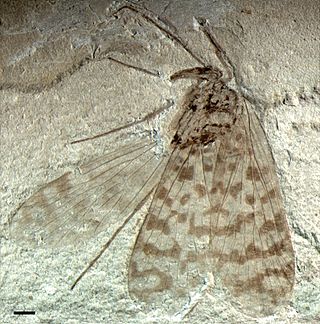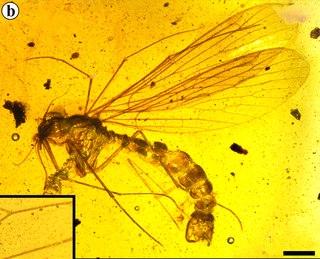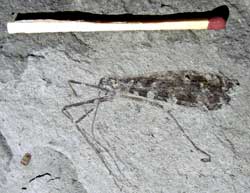
Flea, the common name for the order Siphonaptera, includes 2,500 species of small flightless insects that live as external parasites of mammals and birds. Fleas live by ingesting the blood of their hosts. Adult fleas grow to about 3 millimetres long, are usually brown, and have bodies that are "flattened" sideways or narrow, enabling them to move through their hosts' fur or feathers. They lack wings; their hind legs are extremely well adapted for jumping. Their claws keep them from being dislodged, and their mouthparts are adapted for piercing skin and sucking blood. They can leap 50 times their body length, a feat second only to jumps made by another group of insects, the superfamily of froghoppers. Flea larvae are worm-like, with no limbs; they have chewing mouthparts and feed on organic debris left on their hosts' skin.

Nannochoristidae is a family of scorpionflies with many unusual traits. It is a tiny, relict family with a single extant genus, Nannochorista, with eight species occurring in New Zealand, southeastern Australia, Tasmania, Argentina and Chile. Due to the group's distinctiveness from other scorpionflies, it is sometimes placed in its own order, the Nannomecoptera. Some studies have placed them as the closest living relatives of fleas. Most mecopteran larvae are eruciform, or shaped like caterpillars. Nannochoristid larvae, however, are elateriform, and have elongated and slender bodies. The larvae are aquatic, which is unique among mecopterans. The larvae are predatory, hunting on the beds of shallow streams, primarily on the larvae of aquatic Diptera like chironomids.

Bittacidae is a family of scorpionflies commonly called hangingflies or hanging scorpionflies.

Boreidae, commonly called snow scorpionflies, or in the British Isles, snow fleas are a very small family of scorpionflies, containing only around 30 species, all of which are boreal or high-altitude species in the Northern Hemisphere.

The Panorpidae are a family of scorpionflies containing more than 480 species. The family is the largest family in Mecoptera, covering approximately 70% species of the order. Species range between 9–25 mm long.

Eomeropidae is a family of aberrant, flattened scorpionflies represented today by only a single living species, Notiothauma reedi, known from the Nothofagus forests in southern Chile, while all other recognized genera in the family are known only as fossils, with the earliest definitive fossil known from Liassic-aged strata, and the youngest from Paleogene-aged strata.
The Haifanggou Formation, also known as the Jiulongshan Formation, is a fossil-bearing rock deposit located near Daohugou village of Ningcheng County, in Inner Mongolia, northeastern China.
Mongolbittacus is an extinct genus of hangingfly in the family Bittacidae and containing a single species Mongolbittacus daohugoensis. The species is known only from the Middle Jurassic Jiulongshan Formation, part of the Daohugou Beds, near the village of Daohugou in Ningcheng County, northeastern China.
Jurahylobittacus is an extinct genus of hangingfly in the family Bittacidae and containing a single species Jurahylobittacus astictus. The species is known only from the Middle Jurassic Jiulongshan Formation, part of the Daohugou Beds, near the village of Daohugou in Ningcheng County, northeastern China.

Hylobittacus apicalis is a species of hangingfly in the order Mecoptera, and the only species within the genus Hylobittacus.

Panorpida or Mecopterida is a proposed superorder of Holometabola. The conjectured monophyly of the Panorpida is historically based on morphological evidence, namely the reduction or loss of the ovipositor and several internal characteristics, including a muscle connecting a pleuron and the first axillary sclerite at the base of the wing, various features of the larval maxilla and labium, and basal fusion of CuP and A1 veins in the hind wings. The monophyly of the Panorpida is supported by recent molecular data.

Fortiholcorpa paradoxa is an extinct species of scorpionfly (Mecoptera) from the Middle Jurassic of China. It is the only known species of its genus.

Jurassipanorpa is a genus of fossil scorpionfly containing two species described in 2014 from the Jiulongshan Formation of Inner Mongolia, China. The two species, J. impuctata and J. sticta, lived in the late Middle Jurassic period. Upon description, they were claimed to represent the oldest known representatives of the scorpionfly family Panorpidae, but this was later questioned.

Holcorpa is a genus of extinct insects in the scorpionfly order Mecoptera. Two Eocene age species found in Western North America were placed into the genus, H. dillhoffi and H. maculosa.

Harpobittacus is a genus of hangingfly of the family Bittacidae found in Australia.
2015 in paleoentomology is a list of new fossil insect taxa that were described during the year 2016, as well as other significant discoveries and events related to paleoentomology that were scheduled to occur during the year.

Pseudopolycentropodidae is an extinct family of scorpionflies known from the Mesozoic. Fossils are known from the Middle Triassic (Anisian) to the early Late Cretaceous (Cenomanian). It is part of Mesopsychoidea, a group of scorpionflies with siphonate proboscis. They are suggested to have been nectarivores, feeding off the liquid pollination drops and acting as pollinators for now extinct insect pollinated gymnosperms such as Bennettitales.

Aneuretopsychidae is an extinct family of scorpionflies known from the Mesozoic. Fossils are known from the Jurassic (Callovian-Oxfordian) to the early Late Cretaceous (Cenomanian). It is part of Mesopsychoidea, a group of scorpionflies with siphonate proboscis. They are suggested to have been nectarivores, feeding off the liquid pollination drops of and acting as pollinators for now extinct insect pollinated gymnosperms such as Bennettitales.
Austropanorpa is an extinct genus of scorpionfly. It is the only member of the family Austropanorpidae. The type species, A. australis was described by Edgar Riek in 1952 based on two incomplete forewings from the Redbank Plains Formation of Queensland, of probable Eocene age, and was assigned to Panorpidae. Later, it was recognised as distinctive enough to be assigned to its own monotypic family by Rainer Willman in 1977. In 2018 the species "Orthophlebia" martynovae from the Early Jurassic (Toarcian) aged Cheremkhovo Formation near Lake Baikal in Siberia, described by Irina Sukacheva in 1985, was recognised as belonging to the genus. The genus is distinguished from other mecopterans by having nine branched radial sectors and four veins in the medial sector of both wings, as opposed to living panorpoids which are typically 5 and rarely 6 branched.

Cimbrophlebiidae is an extinct family of scorpionflies. They are considered to be the sister group to the Bittacidae, together forming the clade Raptipedia.




































